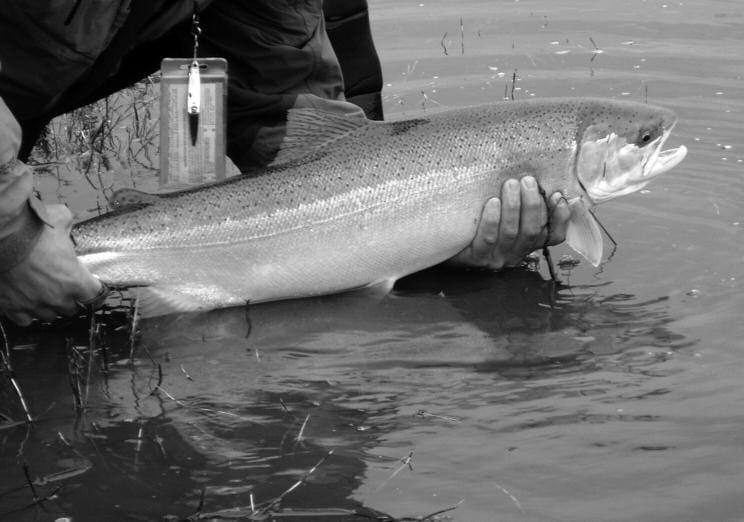Wednesday’s Wild and Wet Winter – Week 8
By Michael Wier
It’s Wednesday’s Wild and Wet Winter … a California Trout, Keepemwet Fishing and Lost Coast Outfitters initiative celebrating California’s wild winter steelhead.
Last week we covered some of the finer points of landing, photographing and releasing a steelhead that’s been hooked while drifting down river in a boat. This week lets discuss some of the other threats, besides recreational angling pressure, that Winter Steelhead face along their journey from fry to adult.
In 2017 California Trout released the SOS II: Fish In Hot Water report which chronicles the status of all 32 Native Salmonids in California based on the latest peer reviewed science and research. Within California, there are actually 8 different classifications of Steelhead; Central California Coast Steelhead, Central Valley Steelhead, Klamath Mountains Province Summer Steelhead, Klamath Mountains Province Winter Steelhead, Northern California Summer Steelhead, Northern California Winter Steelhead, South-Central California Coast Steelhead and Southern Steelhead. Each group of fish displays different traits and behaviors based on their habitat, there for each group is managed differently.
Within the SOS report, each classification of steelhead is given a level of concern based on a number of factors that determine their likelihood to survive long-term without human intervention. Each of the 8 classifications for steelhead range from Moderate, to High, to Critical in their level of concern. That means all 8 groups are in peril and have a likelihood of extirpation from their native range within the next 50 years. Some classification segments, like Southern Steelhead are on the brink of extinction and angling for those fish has not been allowed for many years. Northern California winter steelhead are in a state of long-term decline over much of their range due to land use practices that reduce habitat for juveniles, such as diversions that desiccate nursery tributaries during summer months, therefore they are listed as Moderate level of concern.
The top 3 major anthropogenic threats to winter steelhead listed in the report are:
Major Dams – Scott Dam on the Eel River blocks access to an estimated 290km (180 mi.) of potential habitat, while Matthews Dam on the Mad River blocks nearly a third of historical steelhead habitat. In addition, these dams reduce streamflow during important migration windows for adult and juvenile steelhead.
Estuary Alteration – The estuaries of the Eel and Mad Rivers and Redwood Creek have been leveed, armored with structures, drained, altered by tide gates, and converted for agricultural and rural development, greatly reducing juvenile nursery habitat. What suitable estuarine habitat remains is subject to high turbidity, poor water quality, and sedimentation from runoff.
Agriculture – In the past two decades, illegal water diversions and subsequent habitat degradation of remote headwater streams for marijuana cultivation has become perhaps the most important limiting factor for juvenile steelhead survival in natal streams.
CalTrout is currently engaged in a suite of projects directed to help recover Northern California Steelhead based out of our North Coast office in Arcata California. On the Eel River we have taken a headwaters to estuary approach to restoration. In the estuary, CalTrout is working with the Coastal Conservancy, CDFW and the Wild Lands Conservancy to do large scale restoration, restore tidal marshlands, reconnect the estuary with the sloughs and install fish friendly tide gates. Along the mainstem CalTrout has identified many migration barriers and listed them in order of priority for removal. To date we have already led efforts to remove two large barriers at Bridge Creek and Woodman creek opening up several miles of quality habitat to spawning and rearing. Along the South Fork and other tributaries CalTrout is working on flow studies to help inform regulations that would allow for better instream flows at critical times for salmonids. And in the headwaters our focus is on advocating for fish passage at Scott Dam which would allow Salmon and Steelhead back into over 180 miles of historic quality spawning and rearing habitat. CalTrout is also engaged in a large scale restoration effort on Redwood Creek which includes the restoration of Prairie Creek, and important spawning tributary and restoration of the estuary.
Protecting and restoring habitat for Winter Steelhead is an ongoing mission and CalTrout is committed to ensuring positive outcome for wild fish and helping meet recovery goals.
————————————————————————————————————
CalTrout: to learn more about California winter run steelhead
Keepemwet Fishing: to learn more about Keepemwet principles
Lost Coast Outfitters: blog on many things fly fishing related





